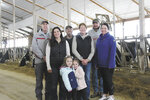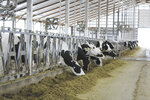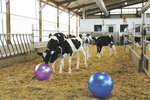


Trent, Kristan, Pete and Jeanne Opelt, of River Crest Dairy LLC | Greenwood, Wisconsin | Clark County | 250 cows
How many times a day do you milk, and what is your current herd average, butterfat and protein? Our cows are milked twice a day. The current herd average is 30,242 pounds of milk with a 4.4% butterfat and 3.4% protein.
Describe your housing and milking facility. All of the cows are housed under one roof in a naturally ventilated, sand-bedded freestall barn with two group calving packs. Cows are milked in a double-8 parallel parlor.
Who is part of your farm team, and what are their roles? The farm team includes the following family members: Trent, feeder; Kristan, herdsman/bookkeeping; Pete, crops/maintenance; Jeanne, calves; Kyle Opelt, crops/maintenance; Lindsay Van Cuyk, calves; and Jerry Noeldner, heifers. We also have two Amish employees and one part-time high school student.
What is your herd health program? A veterinarian comes every other week for herd health. Cows are vaccinated with Bovi-Shield one month after calving. They are vaccinated during the dry period for mastitis with Endovac and for salmonella.
What does your dry cow and transition program consist of? To dry cows off, we move them into the dry cow pen as they leave the parlor. We pull them out of the dry cow pen two days later to be milked out again. Then, two days later, they are milked out one more time and treated with a teat sealant. We started doing this years ago, because it seems to be easier on the cows that are still milking heavy, and with our setup, it is easy to do. We use selective dry cow therapy, only using antibiotics on cows with high somatic cell counts. When we built our barn, we put all the cows under one roof, including dry cows. It eliminates the weekly task of trailering dry cows, and it makes cow movements easy and stress-free through the entire lactation. The dry cow pen is identical to the milking pens, with deep sand-bedded free stalls and fans. Springing heifers are moved to the dry pen two months before calving, which allows time for vaccines, hoof trimming and adjustment to the barn. The group calving packs are located adjacent to the dry pen. Cows and springing heifers are moved to the packs two weeks before calving and remain on the calving packs at least 24 hours after calving before going to the fresh pen. They stay in the fresh pen about 30 days then move to a 2-year-old or mature cow pen for the rest of the lactation. Dry cows and close-ups are fed winter rye, corn silage and minimal haylage, depending on our rye inventory. X-Zelit is top-dressed and mixed in by hand to closeups to prevent milk fever.
What is the composition of your ration, and how has that changed in recent years? Milking cows are fed alfalfa, brown mid-rib corn silage, whey, dry corn and a protein/mineral mix. We have not made any major changes to the ration since adding whey. We tend to make minor adjustments based on forage quality and inventory.
Tell us about the forages you plant and detail your harvest strategies. We plant alfalfa, BMR corn for milking cows, and conventional corn for heifer and dry cow silage. We also started planting winter rye for dry cow feed a few years ago. We plant peas and triticale with our new-seeding alfalfa and harvest it for heifer forage. All forage is custom harvested.
What is your average somatic cell count, and how does that affect your production? Our SCC is around 100,000 according to Dairy Herd Improvement Association testing. It is lower in the tank, because we usually pasteurize milk from a few high SCC cows for calf milk. We used to try hard to keep our SCC lower, but when they stopped paying high premiums for a really low count, we backed off a little on culling and treating mastitis. Production didn’t seem to change.
What change has created the biggest improvement in your herd average? In 2018, we started feeding whey, and it was a game-changer. It’s a pain to work with and requires management, but our components immediately sky-rocketed. If we run into a supply problem with the whey, it causes issues with production.
What technology do you use to monitor your herd? We don’t have a heat detection system or anything fancy to monitor the cows. We use tail paint and walk the pens, which only takes about 15 minutes a day. The parlor is simple and shows milk weights and temperatures, but nothing is recorded back to a computer. Milking employees write down high-temperature cows as they milk.
What is your breeding program, and what role does genetics play in your production level? Cows are bred first service to a G6G program. Then, they are monitored for repeat heats. Beef semen is used on the bottom one-third of the cows, and we’ll probably increase that. The top 50% of heifers get sexed semen on the first service. The remaining services are conventional semen. We are trying to find the balance of how much beef semen to use. Our heifer facilities are sized to the number of heifers we need, so we regularly pick and choose extra heifers to sell after weaning to keep our numbers where we need them. We don’t genomic test, but we know the important role genetics play. We try to be consistent in selecting bulls for pounds of fat and protein, daughter pregnancy rate, udders, feet and legs, and strength. We keep an eye on a number of other traits. We do not intentionally breed for big, tall cows but try to steer clear of bulls that sire shallow, narrow cows.
List three management strategies that have helped you attain your production and component level. Attention to detail in all areas of the farm. Our entire team of family members and employees try to do an exceptional job of taking care of the little things, day in and day out. Consistency with details is critical if you want consistent production. The combination of dry corn and whey has boosted components and profitability. BMR corn silage has helped increase intakes and, therefore, production.
Tell us about your farm and your plans for the dairy in the next year. River Crest Dairy LLC is owned by Pete and Jeanne Opelt, their son, Trent, and his wife, Kristan. The LLC was formed in 2015 when the freestall barn and parlor were built to combine the two tiestall herds. In 2017, a calf barn with automatic feeders was built. We raise our heifers and farm almost 700 acres, growing all of our own forage and grain corn. We do not have any major plans for the next year. We want to continue to try to get more production from the cows and the acres that we have.
Comments
No comments on this item Please log in to comment by clicking here